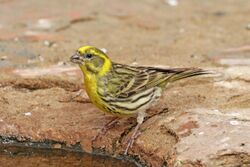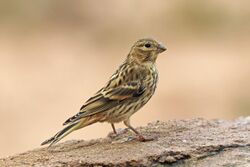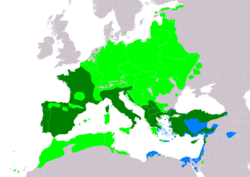Biology:European serin
| European serin | |
|---|---|

| |
| Male | |

| |
| Female both Souss-Massa National Park, Morocco | |
| Scientific classification | |
| Domain: | Eukaryota |
| Kingdom: | Animalia |
| Phylum: | Chordata |
| Class: | Aves |
| Order: | Passeriformes |
| Family: | Fringillidae |
| Subfamily: | Carduelinae |
| Genus: | Serinus |
| Species: | S. serinus
|
| Binomial name | |
| Serinus serinus (Linnaeus, 1766)
| |

| |
| Range of S. serinus Breeding Resident Non-breeding
| |
| Synonyms | |
|
Fringilla serinus Linnaeus, 1766 | |
The European serin, or simply the serin (Serinus serinus), is the smallest species of the family of finches (Fringillidae) and is closely related to the Atlantic canary. Its diet consists mainly of a combination of buds and seeds.
Taxonomy
The European serin was described by Carl Linnaeus in 1766 in the 12th edition of his Systema Naturae under the binomial name Fringilla serinus.[2][3] The Latin serinus comes from the French word serin for a canary. The French word may be a corruption of the Latin word citrinus meaning "lemon-coloured".[4]
Description
The European serin is a small short-tailed bird, 11–12 cm in length. The upper parts are dark-streaked greyish green, with a yellow rump. The yellow breast and white belly are also heavily streaked. The male has a brighter yellow face and breast, yellow wing bars and yellow tail sides. The song of this bird is a buzzing trill, very familiar in Mediterranean countries.
It breeds across southern and central Europe and North Africa. Southern and Atlantic coast populations are largely resident, but the northern breeders migrate further south in Europe for the winter. Open woodland and cultivation, often with some conifers, is favoured for breeding. It builds its nest in a shrub or tree, laying 3–5 eggs. It forms flocks outside the breeding season, sometimes mixed with other finches.
The food is mainly seeds, and, in the breeding season, insects. This small serin is an active and often conspicuous bird.
References
- ↑ BirdLife International (2018). "Serinus serinus". IUCN Red List of Threatened Species 2018: e.T22720049A132136209. doi:10.2305/IUCN.UK.2018-2.RLTS.T22720049A132136209.en. https://www.iucnredlist.org/species/22720049/132136209. Retrieved 12 November 2021.
- ↑ Linnaeus, C. (1766) (in Latin). Systema Naturæ per regna tria naturae, secundum classes, ordines, genera, species, cum characteribus, differentiis, synonymis, locis, Volume 1. 1 (12th ed.). Holmiae:Laurentii Salvii. p. 320. https://www.biodiversitylibrary.org/page/42946516.
- ↑ Paynter, Raymond A. Jnr., ed (1968). Check-list of birds of the world, Volume 14. 14. Cambridge, Massachusetts: Museum of Comparative Zoology. p. 210. https://www.biodiversitylibrary.org/page/14481411.
- ↑ Jobling, James A (2010). The Helm Dictionary of Scientific Bird Names. London: Christopher Helm. p. 354. ISBN 978-1-4081-2501-4. https://archive.org/details/Helm_Dictionary_of_Scientific_Bird_Names_by_James_A._Jobling.
External links
- Audio recordings from Xeno-canto
- European Serin videos, photos & sounds on the Internet Bird Collection
- Ageing and sexing by Javier Blasco-Zumeta & Gerd-Michael Heinze
- Oiseaux Photographs, text, map.
Wikidata ☰ Q271807 entry
 |




